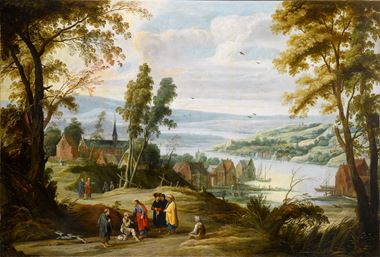
omper II Joos de
(Antwerp 1564 - Antwerp 1635)
 Biography
Biography Christ Healing the Blind Man
Biography
Joos de Momper II received his first training from his father, and as early as 1581 he was registered as a master in the Antwerp Guild of St Luke by his father—who was at the time the dean of the Guild. In Antwerp on 4 September 1590 Joos married Elisabeth Gobyn, by whom he had ten children, including Gaspard and Philips. In 1611 Joos became Dean of the Guild, and the following year he evidently went to Brussels with Sebastiaen Vrancx on guild business. It has long been maintained that de Momper had gone to Italy in the 1580s, since Lodewijk Toeput, who was then active in Venice, was mentioned as his teacher in an inventory of 1624. That this hypothetical trip to Italy actually took place was proved in 1985 when the frescoes in the church of San Vitale in Rome, previously attributed to Paul Bril, were given to Joos de Momper the younger.
Over 500 paintings have been attributed to de Momper, but only a few are signed and only one is dated, the Mountain Landscape (1623; Private Collection). De Momper painted two kinds of landscape: panoramic or ‘fantastic world landscapes’ in the tradition of Joachim Patinir and those in the manner of Jan Breughel the elder, in which the forms are already much more realistic. The panoramic landscapes follow the conventional colour scheme of late Mannerist landscape painting, with tones of brown used for foreground, green for the middle ground and blue for the background. Yet the separate narrative scenes within the compositions are already very individual and strikingly decorative. The artist’s painting technique is characterized by rapid, flowing brushstrokes that sharply define the contours of the foreground; also typical are tiny dots of impasto colour used to create the aerial perspective in the background and the modeling of the middle ground. This is particularly noticeable in his panoramic landscapes with a high viewpoint, such as the Wide River Landscape with a Boar Hunt (Amsterdam, Rijksmuseum), the Mountain Landscape with a Company of Riders (Madrid, Prado), the Mountain Landscape with a Water-mill (Dresden, Gemäldegallerie Alte Meister) and the Mountain Landscape with Dancing Figures (University of Rochester, New York).
The Mountain Landscape with Bridges (Cologne, Wallraf-Richartz-Museum) represents the other type of mountain landscape: the viewpoint is lower, and the foreground is flat and bordered by steep rocks, like stage scenery for the figures. However, the figures are always—unlike those in Breughel’s images—without narrative meaning. Joos de Momper’s landscapes are usually conventionally framed on the sides with groups of trees or rocks; the real development takes place in the importance given to the centre of the composition. Here he explored the potential of the flat Dutch landscape by varying the viewpoint, which gradually sinks, culminating in the so-called grotto landscapes (e.g. Landscape with a Grotto and Painter, Bonn, Rhein. Landesmuseum; Waterfall in a Cave, University of Manchester, Whitworth), in which the picture seems to flow out from a figure placed almost at eye-level with the viewer.
Alongside the numerous mountain landscapes, which earnt the painter the nickname ‘pictor montium’ on his portrait in van Dyck’s Iconolography (c. 1632–44), Joos also painted other types of paintings. In his town and village landscapes, the houses and people, previously mere accessories in the mountain landscapes, became the main focus of the pictures, as in the Washing Place in Flanders (Madrid, Prado), with its wandering perspective disappearing into a broad bluish distance, and in Autumn (Brunswick, Herzog Anton Ulrich-Museum). The houses in the middle ground of the latter almost close off the composition. This convention is most common in the so-called winter landscapes (e.g. Winter Landscape with a Village and Antwerp Cathedral, Germany, Private collection), in which the village scene spreads over the middle of the whole picture. There are countless variations of these landscapes by de Momper, who is generally seen as the inventor of the genre landscape. He is also well known for his cycles of Seasons, the best of which is in Brunswick (Herzog Anton Ulrich-Museum). These landscapes alternate between high and low viewpoints, referring back to the compositions of the panoramic landscapes.
However, in terms of technique, execution and the amount of detail, they are already close to 17th-century realistic landscape painting. There is also a small group of drawings attributed to him, for example Rider Crossing the Mountains 1578, Courtauld Institute, London); these follow the development of his landscape paintings.
Joos de Momper’s pictures were already greatly valued during his lifetime; they were first mentioned in inventories c. 1608. He was also praised by van Mander as early as 1604. His mountain landscapes were included in contemporary cabinet pictures by Frans Francken the younger, Jan Breughel the elder, Willem van Haecht etc. Some of these artists—for instance Francken and Breughel—as well as Sebastiaen Vrancx, Jan Breughel the younger and Hendrik van Balen painted figures in Momper’s mountain landscapes. However, the extent of their collaborative work has not been examined in detail.
Collections
Momper II is represented in the following collections: Amsterdam, Rijksmuseum; Madrid, Prado; Dresden, Gemäldegallerie Alte Meister; Herzog Anton Ulrich-Museum, Brunswick; Courtauld Institute, London, amongst others.









